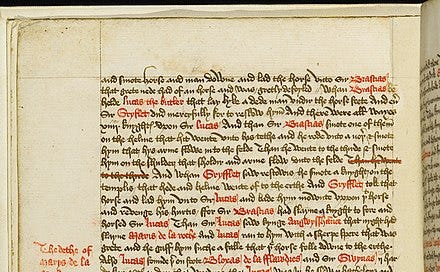Do-Not-Miss Middle English Masterpiece #5
King Arthur! Guinevere! Lancelot! What's not to love?
Dear bookish friend,
I decided to start a fun little series for all you paid subscribers in order to thoroughly revel in my English department roots. I need a little fun in my life, and what's more fun than revisiting and debating five do-not-miss masterpieces of Middle English, followed by five tier-two-delights that often fly under the radar? Each of these will discuss the history of the works, good translations or strategies of reading, and any other hot takes I have. In other words, let’s revel in beautiful English and maybe read some things we haven’t revisited in a long time—or ever visited at all!
Today, clocking in at number five, I bring you the delights of the original bedtime story extravaganza, Le Morte Arthur by Sir Thomas Malory, completed somewhere between 1469-1471. In classic premodern fashion, this was not its original title, but the title of a portion of it—so it was retitled, time and time again, with exceptionally long titles like The Boke of Kyng Arthur Somtyme Kynge of Englande and His Noble Actes and Feates of Armes of Chyvalrye (1489) or The Boke of the Moost Noble and Worthy Prince Kyng Arthur Somtyme Kyng of Grete Brytayne Now Called Englande (1529). As you can tell from these proliferating titles, it was printed early (by Caxton himself, as well as his successor, Wynkyn de Worde, which remains one of the best publisher names of all time!) and reprinted frequently, one of the very first somewhat modern bestsellers. Sidenote: I love premodern titling practices—maybe I should adopt it as well. Should I change the name of Medievalish to The On-lyne Boke of the Moost Earnest and Unworthy but Trying Grace Hamman, Sometyme Medievalist Scholar of Colorado? It has a certain ring.
Keep reading with a 7-day free trial
Subscribe to Medievalish with Grace Hamman to keep reading this post and get 7 days of free access to the full post archives.



